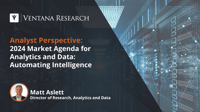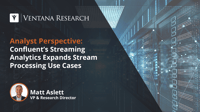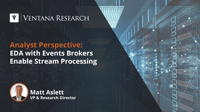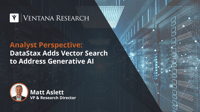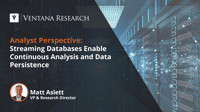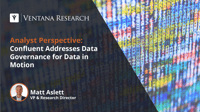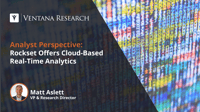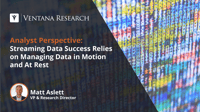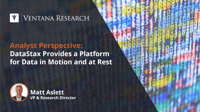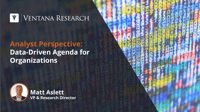Ventana Research recently announced its 2024 Market Agenda for Analytics and Data, continuing the guidance we have offered for two decades to help enterprises derive optimal value and improve business outcomes.
Read More
Topics:
embedded analytics,
Business Intelligence,
Data Governance,
Data Management,
natural language processing,
data operations,
Process Mining,
Streaming Analytics,
AI & Machine Learning,
Analytics & Data,
Streaming Data & Events,
analytic data platforms,
Operational Data Platforms
I recently wrote about the various technologies used by organizations to process and analyze data in real time. I explained that while the terms streaming data and events and streaming analytics are often used interchangeably, they are separate disciplines that make use of common underlying concepts and technologies such as events, event brokers and event-driven architecture. Confluent’s acquisition of Immerok earlier this year provided a reminder of this fact. Confluent is one of the most...
Read More
Topics:
Analytics,
Cloud Computing,
Data Governance,
Data,
Digital Technology,
Streaming Analytics,
Streaming Data & Events
Real-time business is a modern phenomenon, and business transformation has accelerated many business events in recent years. However, the execution of business events has always occurred in real time. Rather, it is the processing of the data related to business events that has accelerated instead of the event itself.
Read More
Topics:
Analytics,
Data,
Streaming Analytics,
Streaming Data & Events
As I have previously explained, we expect an increased demand for intelligent operational applications infused with the results of analytic processes, such as personalization and artificial intelligence-driven recommendations. These systems rely on the analysis of data in the operational data platform to accelerate worker decision-making or improve customer experience.
Read More
Topics:
Analytics,
Data,
Digital Technology,
Streaming Analytics,
AI & Machine Learning,
Analytics & Data,
Streaming Data & Events,
Operational Data Platforms
Success with streaming data and events requires a more holistic approach to managing and governing data in motion and data at rest. The use of streaming data and event processing has been part of the data landscape for many decades. For much of that time, data streaming was a niche activity, however, with standalone data streaming and event-processing projects run in parallel with existing batch-processing initiatives, utilizing operational and analytic data platforms. I noted that there has...
Read More
Topics:
Analytics,
Data,
Digital Technology,
Streaming Analytics,
Analytics & Data,
Streaming Data & Events,
analytic data platforms,
Operational Data Platforms
I recently wrote about the need for organizations to take a holistic approach to the management and governance of data in motion alongside data at rest. As adoption of streaming data and event processing increases, it is no longer sufficient for streaming data projects to exist in isolation. Data needs to be managed and governed regardless of whether it is processed in batch or as a stream of events. This requirement has resulted in established data management vendors increasing their focus on...
Read More
Topics:
Big Data,
Cloud Computing,
Data Governance,
Streaming Analytics,
Streaming Data & Events
I have written recently about increased demand for data-intensive applications infused with the results of analytic processes, such as personalization and artificial intelligence (AI)-driven recommendations. Almost one-quarter of respondents (22%) to Ventana Research’s Analytics and Data Benchmark Research are currently analyzing data in real time, with an additional 10% analyzing data every hour. There are multiple data platform approaches to delivering real-time data processing and analytics...
Read More
Topics:
Cloud Computing,
Data,
Streaming Analytics,
Analytics & Data,
Streaming Data & Events,
analytic data platforms,
operational data plaftforms
I recently noted that as demand for real-time interactive applications becomes more pervasive, the use of streaming data is becoming more mainstream. Streaming data and event processing has been part of the data landscape for many decades, but for much of that time, data streaming was a niche activity. Although adopted in industry segments with high-performance, real-time data processing and analytics requirements such as financial services and telecommunications, data streaming was far less...
Read More
Topics:
Big Data,
Data,
Streaming Analytics,
Analytics & Data,
Streaming Data & Events
Streaming data has been part of the industry landscape for decades but has largely been focused on niche applications in segments with the highest real-time data processing and analytics performance requirements, such as financial services and telecommunications. As demand for real-time interactive applications becomes more pervasive, streaming data is becoming a more mainstream pursuit, aided by the proliferation of open-source streaming data and event technologies, which have lowered the cost...
Read More
Topics:
Data,
Streaming Analytics,
Streaming Data & Events,
operational data plaftforms
When joining Ventana Research, I noted that the need to be more data-driven has become a mantra among large and small organizations alike. Data-driven organizations stand to gain competitive advantage, responding faster to worker and customer demands for more innovative, data-rich applications and personalized experiences. Being data-driven is clearly something to aspire to. However, it is also a somewhat vague concept without clear definition. We know data-driven organizations when we see them...
Read More
Topics:
embedded analytics,
Analytics,
Business Intelligence,
Data Governance,
Data Integration,
Data,
Digital Technology,
natural language processing,
data lakes,
data operations,
Streaming Analytics,
AI & Machine Learning,
Digital Business,
Data Platforms,
Analytics & Data,
Streaming Data & Events
